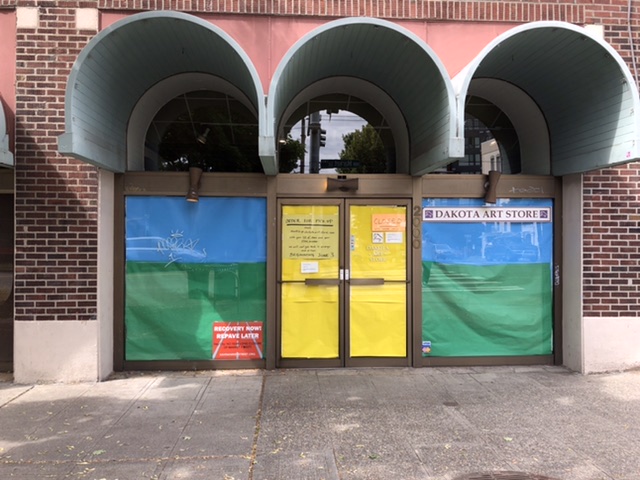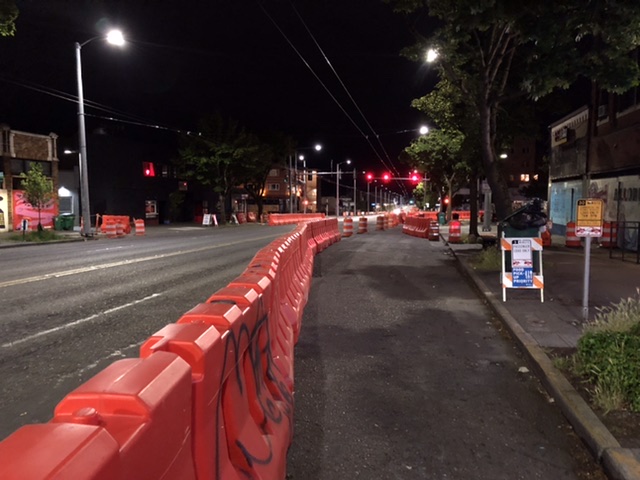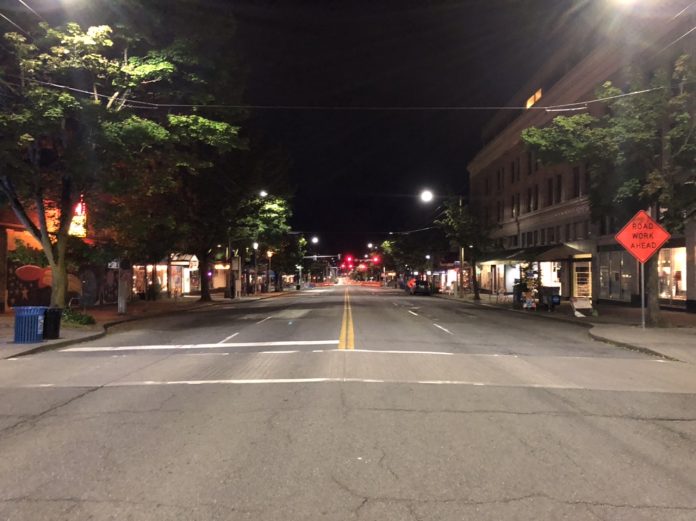Business windows along Market Street in Ballard have been featuring a new sign. In addition to reduced hours with delivery information and the murals painted over plywood panels, there are signs saying “Recovery Now! Repave Later!” appearing in shops and restaurants.
The posters come from Ballard Alliance, who is requesting an 18-month delay in repaving Market Street. The repaving project is actually a complete rebuilding of the road surface between 15th Avenue and 24th Avenue and sidewalk improvements for tree pits and curb ramps. (The Burke Gilman Trail “Missing Link” section of Market Street to the west and nearing completion.) Seattle Department of Transportation (SDOT) proposed starting the project after Ballard Seafood Fest with completion over a year later. Covid-19 has changed construction schedules and cancelled events, but the repaving project looks to be moving ahead as planned.

In some ways, the signs and the debate are pleasant reminders that the business of community continues in extremely difficult times. The sun rises. Potholes get filled. Seattle squabbles over construction. In other ways, it is a stark reminder that a desire for normalcy can cover up how business as usual can be damaging to a community.
Market Street is not minor road. It carries five bus routes (including the fastest growing ones in the country) and 20,400 vehicles each day. This impact is causing the underlying concrete to structurally fail. Of the four Market Street road segments surveyed for pavement condition by SDOT, three are considered to have their structural concrete “failed” and the fourth was in poor condition. The repaving project will rebuild the road from the soil up. Off the roadway, the project will repair sidewalks, expand tree wells, and install new crosswalks and accessible curb ramps. Funding for the project comes from the Levy to Move Seattle and is part of SDOT’s Arterial and Asphalt and Concrete (AAC) Paving Program. The completed project will secure the integrity of the street for 50 years.
Construction of this sort requires detours and rerouting. The roadway will be divided in thirds, with a lane for traffic in each direction and construction occurring on the other third. When work is completed in one section, crews rearrange the diversions and move traffic onto the completed section and construction starts on another part of the street. Pedestrian traffic is rerouted as possible and necessary.
The appeal of delaying construction is very evident during a walk down Market Street. A cluster of “Recovery Now! Repave Later!” signs are on the north side of Market Street between 22nd Avenue and 24th Avenue. Starbucks on the corner has messages in its windows to the patrons waiting outside. Kick It Boutique and Anne’s Framing have their windows screened. Secret Garden Books is only opening its doors for call-in orders. Pie Bar’s long standing order window looks prescient. Three businesses are completely shuttered, still being repaired after the devastating fire that also left the end of the block vacant.

Ballard Alliance argues that the current economic situation is too precarious for restaurants and shops to lose curbside pickup and outside dining space. According to Mike Stewart, Executive Director of the Ballard Alliance via email, “If this project is permitted to go forward it will, at best, prolong the painful recovery of most businesses.” At worst, he says, this will force some Ballard businesses to close their doors forever.
He sees lessons in the impact that construction is already having on businesses further west on Market Street. Under another project, the Ballard Multimodal Corridor, construction has been underway on Market Street west of 24th Avenue for about a year. That project is also a complete rebuilding of Market Street to the subsurface with new overhead transit wires and sidewalk repair, but adds the construction of the Burke Gilman Trail missing link.

Disruption caused by the Ballard Multimodal Corridor project lead to the Alliance and several of its members to express concerns about the project in writing with SDOT. That was also where the discussion of delaying the remaining repaving project arose, but the Ballard Alliance never received a written response. Further communications with SDOT were also unreturned. Through a spokesperson, the Department said, “We have been having conversations with local businesses and take their concerns seriously.” SDOT is internally discussing project timelines and will update the public “in the coming weeks.”
SDOT does recognize the impacts that Covid shutdowns are having on transportation and businesses. Part of the schedule considerations are to take advantage of reduced traffic. The Department is looking for ways to accelerate the process of applying for business enhancements like sidewalk cafés and parklets. And Covid-era projects connect directly to the repaving zone. The 17th Avenue Stay Healthy Street connects at the east end of the project. Construction will block Market Street at Ballard Avenue where significant discussion about opening up the road for streateries has found support in the City Council.
That does raise an interesting question not just about the process of repaving the street, but what the final product is going to look like. While the businesses of Ballard ask for a pause in repaving, we can take a step further and reexamine the assumptions of what Market Street should be.
SDOT identifies NW Market St as “an east-west arterial and considered a major truck street in Seattle’s freight network” though years of changes have made such designations antiquated at best. Most segments of the road are 60 feet wide with four travel lanes. While Market Street is the major route through the Ballard Urban Village, the designs for repaving show SDOT is not actually considering Market Street as an Urban Village arterial. The road is being rebuilt as a major urban highway.

The designs for repaving do not consider any increase in the size of the sidewalks. There is no addition of protected bike lanes or transit-only lanes, just spaces for parking. The design does not address how the newly minted Stay Healthy Street on 17th Avenue interacts with this four-lane highway. The plans do not show space for street cafes and enough space to socially distance. This is a design for a pre-Covid era.

Seattle has been in this position before. In the rush to replace the Viaduct, we failed to listen to the people who said the traffic projections were off and that the design did not consider transit and pollution. When the drilling machine stalled, we had two years to reconsider the project. We didn’t, which has left us with an underused, over-budget, and delayed hole in the ground.
Perhaps Covid is the errant steel pipe in the way of making a similar mistake on Market Street. As Mike Stewart of the Ballard Alliance puts it, charging ahead with repaving is a “preventable tipping point” for businesses in the heart of Ballard. Events are changing how much space we need on our sidewalks and what we expect our neighborhoods to look like. A rush to repave suggests that three months of social distancing will leave us all unchanged.
The 18-month reprieve requested by businesses is the bare minimum for the Market Street repaving project. During that time, the current plans should be scrapped and replaced with a redesign that considers what a new normal looks like. People in 50 years are going to study what the Covid era did to us. If we expect this project to survive until that time, we should get it right.
Send your comments to NWMarket@seattle.gov.
Ray Dubicki is a stay-at-home dad and parent-on-call for taking care of general school and neighborhood tasks around Ballard. This lets him see how urbanism works (or doesn’t) during the hours most people are locked in their office. He is an attorney and urbanist by training, with soup-to-nuts planning experience from code enforcement to university development to writing zoning ordinances. He enjoys using PowerPoint, but only because it’s no longer a weekly obligation.



